- MENU
- HOME
- SEARCH
- WORLD
- MAIN
- AFRICA
- ASIA
- BALKANS
- EUROPE
- LATIN AMERICA
- MIDDLE EAST
- United Kingdom
- United States
- Argentina
- Australia
- Austria
- Benelux
- Brazil
- Canada
- China
- France
- Germany
- Greece
- Hungary
- India
- Indonesia
- Ireland
- Israel
- Italy
- Japan
- Korea
- Mexico
- New Zealand
- Pakistan
- Philippines
- Poland
- Russia
- South Africa
- Spain
- Taiwan
- Turkey
- USA
- BUSINESS
- WEALTH
- STOCKS
- TECH
- HEALTH
- LIFESTYLE
- ENTERTAINMENT
- SPORTS
- RSS
- iHaveNet.com
David LaGesse
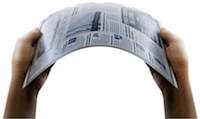
Carrying a real book is at risk of looking old-fashioned, especially with the upcoming rush of digital E-readers.
Several dozen models descended on the Consumer Electronics Show last month in Las Vegas, where a large corner of one hall was dedicated to the electronic readers.
The surge is fueled partly by the affection that owners have showered on their Amazon Kindles and Sony Readers, pioneers that helped popularize the new devices.
Nearly everyone who has bought one -- about 93 percent of owners -- is happy with it, according to research from
But they've also appealed to a limited group of avid readers who buy a lot of books. The coming wave tries to expand the audience with models that can surf the Web, handle E-mail, watch videos, and perform any number of other computerlike tricks.
Most models maintain a monochrome screen that's optimized for reading text, but others combine it with a second, color screen for other tasks. Some are more like tablets in the vein of Apple's iPad, which generated consumer excitement with its rich color display, iPhone apps, and video streaming. And, oh yeah, it can also be used for reading books.
Other devices keep just one screen and its focus on reading, but they make it big enough to display more of a page and in a design that's true to the look of a newspaper or magazine. Their developers argue that readers or tablets can succeed without having to replace a smart phone at one end or a notebook at the other end.
Busy executives, for one, have smart phones and notebooks but still carry stacks of newspapers, magazines, and their own work documents, says Daren Benzi of Plastic Logic, developers of the Que E-reader. "It's a lot more convenient to have all that paper at their fingerprints in one device," he says. "We think there's room for another device to fit in between."
To help find the proper fit, we've identified five E-readers that illustrate key distinctions among the many choices about to descend on shoppers:
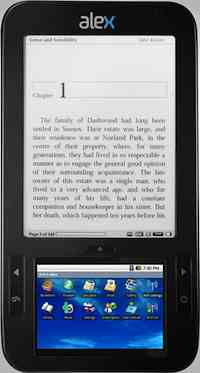
The Alex E-reader
Alex
The Alex from Spring Design is among several E-readers that follow the Barnes & Noble Nook in terms of combining multiple screens.
Like the Nook, the Alex achieves this on one face with a 6-inch, monochrome screen for reading books, while below that is a 3.5-inch
color touch-screen. The similarity, in fact, led to a lawsuit filed by Spring Design against
Alex's color screen looks more useful than the Nook's. On the Alex, it can browse the Web, send and receive E-mail, annotate books, and run other applications.
The Alex runs the Android software that's on a growing list of smart phones and can download some of the same software.
Given the bad blood with
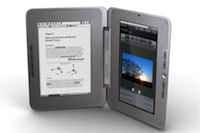
eDGe E-Reader
eDGe
The eDGe from Entourage Systems is another reader that combines two screens: a 9.7-inch display for books and publications and a 10.1-inch liquid crystal display.
The LCD is actually a full-bore, touch-screen netbook running on the Android system from Google. That gives it a Web browser, E-mail, and other software, including applications that can be downloaded and are already used on Android smart phones. The netbook has no keyboard, relying on a software version, again like many smart phones. The E-reader uses the same E-ink tech as Amazon's Kindle.
Weighing 3 pounds, the eDGe has a unique, rotating hinge between its screens. It can fold closed, fold partway to sit upright on a
desk, or lie completely flat with screens on either side. Content can be loaded via Wi-Fi wireless, SD memory cards, or a USB connector.
The eDGe also has a built-in camera and microphone. The eDGe is expected in March for
[While Android sneaks onto netbooks, Windows 7 is proving a worthy competitor.]
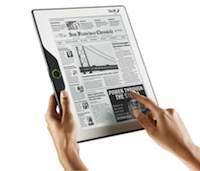
Skiff E-Reader
Skiff
The thinnest E-reader announced to date at about a quarter-inch thick, the Skiff has a 11.5-inch screen that can display publications in black-and-white designs reminiscent of their print versions.
The separate Skiff service will sell and deliver publications and books to the reader through a high-speed connection with
The Skiff uses a flexible-screen technology based on a sheet of stainless steel foil, though early models won't bend.
The reader weighs just over a pound and could last a week between charges, depending on use.
Skiff execs say that they'll make the downloading service and publications store available to other devices and that they hope one day to get out of the hardware business altogether.
The Skiff is due later this year, though prices haven't been announced.
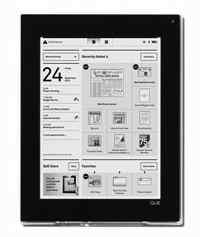
Que E-Reader
Que
With its large-format and thin design, Plastic Logic is taking aim at a particular group -- business professionals -- with its Que reader. The Que's 10.7-inch, gray-scale display taps a library of books, newspapers, and magazines, many with a business focus.
The software can also display Microsoft Word and Excel files and has a calendar that syncs with Outlook. It's one of several readers allied with
Only a third of an inch thick, the Que sports a British-developed screen that is said to be shatterproof.
It's based on new plastic substrates that make it theoretically bendable (though not in the Que). Books are displayed with the same easy-to-read E-ink as Amazon's Kindle. The reader will present publications in formats similar to their print counterparts. Shipping in April, a Wi-Fi model will cost
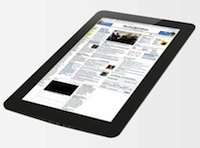
JooJoo E-Reader
JooJoo
Perhaps the most similar to Apple's iPad, the JooJoo has a 12.1-inch color touch-screen that's ready for Web surfing, document work, and high-definition video.
But unlike the iPad, the JooJoo supports Microsoft Silverlight and Adobe Flash, which opens it to streaming videos from the popular
The JooJoo is about a half-inch thick and weighs about 2.5 pounds with Wi-Fi and Bluetooth connections and a built-in webcam. The name comes from a West African term for an object's mystical properties, and maker Garage Fusion claims users can be surfing in a magical 9 seconds. The device has been the subject of a disagreement among original backers that spilled into a lawsuit. But Singapore-based Garage Fusion says it raised added capital and is plowing ahead with JooJoo's release.
Deliveries are expected later this spring at